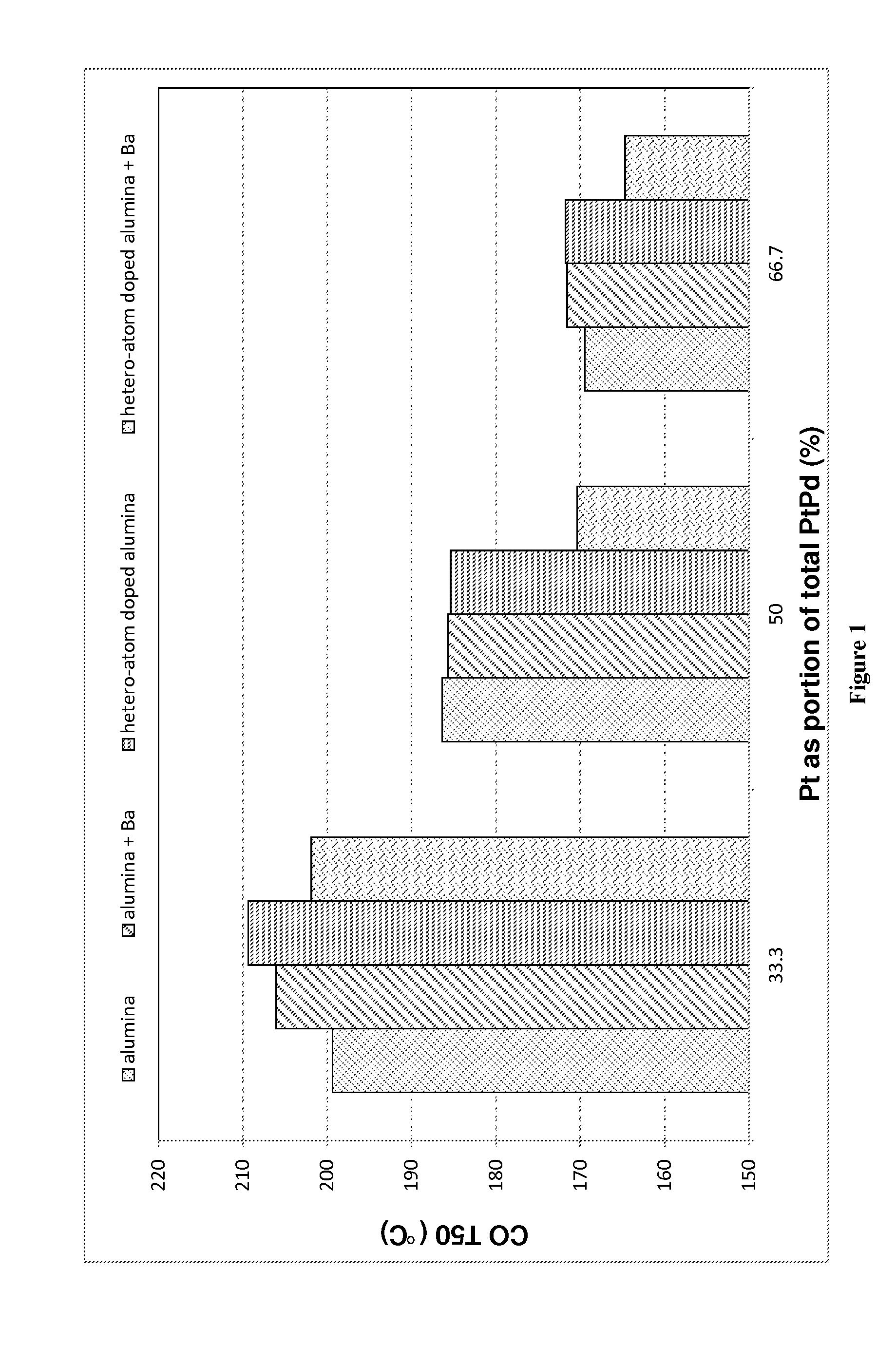Oxidation Catalyst for Treating the Exhaust Gas of a Compression Ignition Engine
a technology of oxidation catalyst and compression ignition engine, which is applied in the direction of metal/metal-oxide/metal-hydroxide catalyst, machine/engine, etc., can solve the problems of low cost of palladium and platinum, and achieve the relative cost of palladium to platinum, improve catalyst durability, and reduce the effect of cos
- Summary
- Abstract
- Description
- Claims
- Application Information
AI Technical Summary
Benefits of technology
Problems solved by technology
Method used
Image
Examples
example 1
Preparative Methods
[0220]Samples containing an alkaline earth metal component and alumina doped with a heteroatom component as a support material were prepared as follows.
[0221]Silica doped alumina powder was slurried in water and milled to a d90 <20 micron. Barium acetate was added to the slurry followed by appropriate amounts of soluble platinum and palladium salts. The slurry was then stirred to homogenise. The resulting washcoat was applied to a cordierite flow through monolith having 400 cells per square inch using established coating techniques. The part was dried and calcined at 500° C.
[0222]For comparative purposes, samples containing alumina doped with a heteroatom component as a support material, but without the alkaline earth metal component were also prepared. The method above was used to prepare the samples except that the step of adding barium acetate was omitted.
[0223]As a further comparison, samples containing conventional alumina as a support material with and witho...
example 2
[0229]Samples containing alumina doped with 5% silica, Pt:Pd in a mass ratio of 1:1 at a total
[0230]PGM loading of 50 gft−3 and varying amounts of barium were prepared using the method described above. The CO T50 light off temperatures were also measured using the same procedure as set out above.
Results
[0231]The results of the CO “light-off” measurements are shown in Table 2 below.
TABLE 2Sample No.Amount of Ba (gft−3)CO T50 (° C.)2-1 01862-21501702-3300166
example 3
Preparative Method
[0232]Silica doped alumina powder was slurried in water and milled to a d90 −3. The slurry was then stirred to homogenise. The resulting washcoat was applied to a cordierite flow through monolith having 400 cells per square inch using established coating techniques. The part was dried and calcined at 500° C. The CO T50 light off temperatures were also measured using the same procedure as set out above.
Results
[0233]The results of the CO “light-off” measurements are shown in Table 3 below.
TABLE 3SampleAlkaline EarthAmount ofCO T50No.Metal (AEM)AEM (gft−3)Support(° C.)3-1Ba100A11643-2Ba150A21663-3Sr150A11783-4Sr300A1176
[0234]Catalysts containing strontium show a lower CO T50 light off than a comparative catalyst without strontium (see Sample 2-1 in Table 2). Samples 3-1 and 3-2 show that a reduction in CO T50 light off is achieved using two different hetero-atom doped aluminas Support Al is a 5% silica doped alumina and support A2 is a 10% silica doped alumina.
PUM
| Property | Measurement | Unit |
|---|---|---|
| temperatures | aaaaa | aaaaa |
| particle size | aaaaa | aaaaa |
| specific surface area | aaaaa | aaaaa |
Abstract
Description
Claims
Application Information
 Login to View More
Login to View More - R&D
- Intellectual Property
- Life Sciences
- Materials
- Tech Scout
- Unparalleled Data Quality
- Higher Quality Content
- 60% Fewer Hallucinations
Browse by: Latest US Patents, China's latest patents, Technical Efficacy Thesaurus, Application Domain, Technology Topic, Popular Technical Reports.
© 2025 PatSnap. All rights reserved.Legal|Privacy policy|Modern Slavery Act Transparency Statement|Sitemap|About US| Contact US: help@patsnap.com

